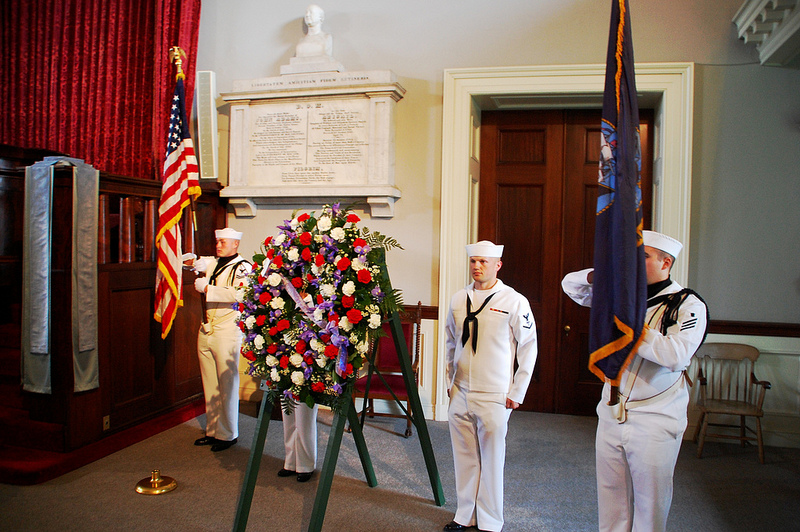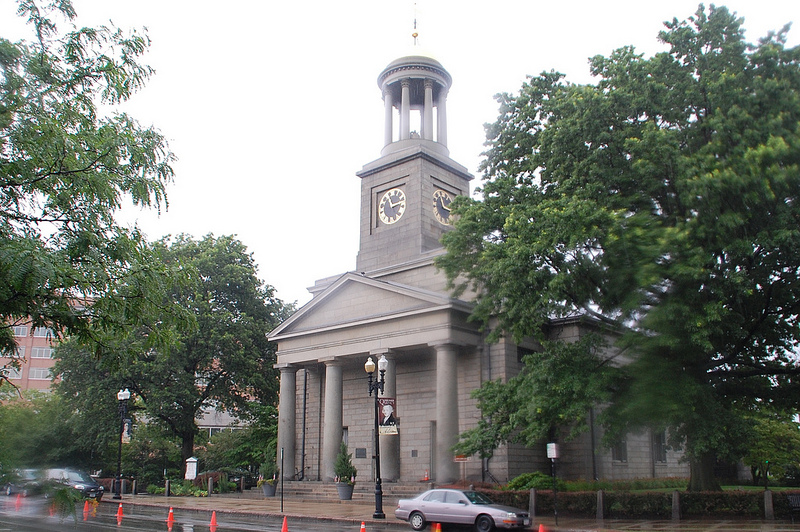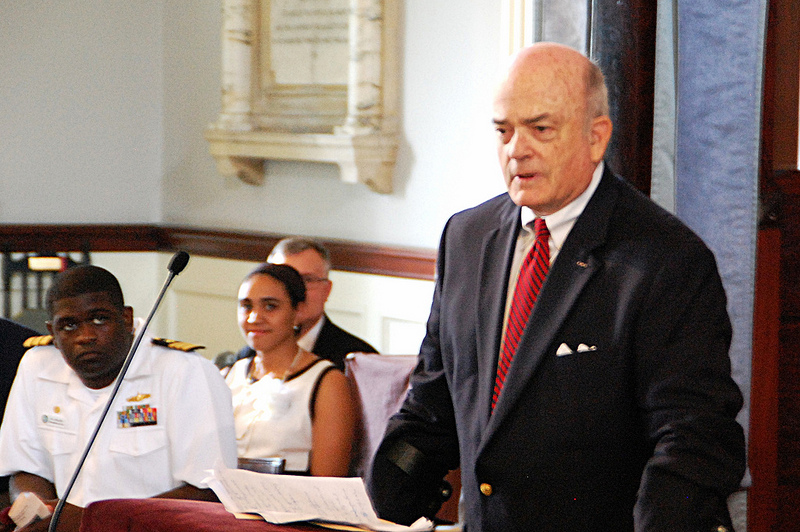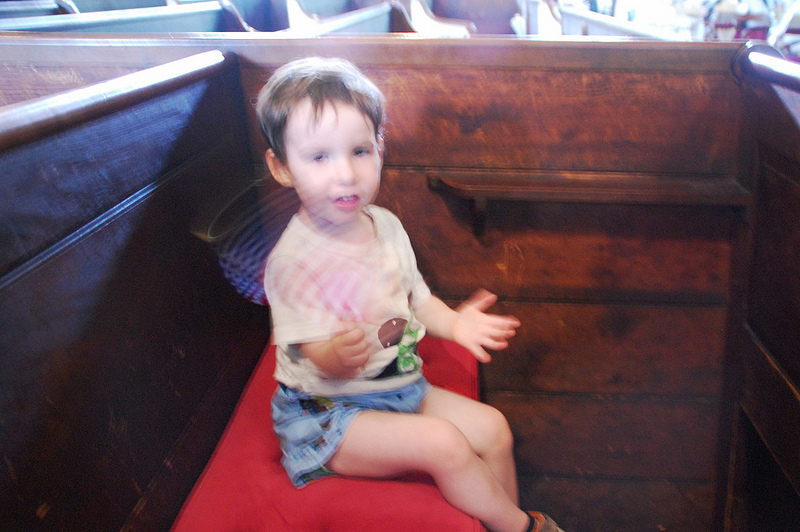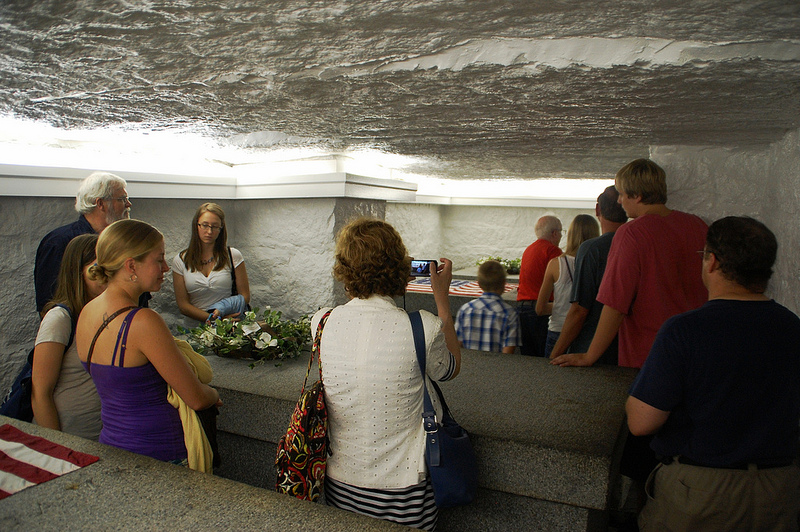This week the two year old and I drove down to Quincy, Massachusetts, to take part in a birthday party for President John Quincy Adams. Now each year, on each president’s birthday, the White House sends a wreath to the gravesite to mark the occasion, and it appears to be up to the locals as to what more to do beyond that. The folks at First United Parish Church in Quincy – home to the tombs of both John Adams and John Quincy Adams (and nicknamed the “City of Presidents” as a result) – play it up big. “You should see it in October,” one of the church guides told me, referring to the John Adams’ birthday event held in the fall, when grade school classes take part. “It’s even more elaborate.” I’m not entirely sure how that’s possible, as this was a pretty fancy birthday party. Boy was I glad we decided to come down and take part.
The church is at the heart of a “presidential district” where there is an Adams Building and a Presidential Pub and lots of “Discover Adams” banners up on the lampposts. Quincy’s mayor, Thomas Koch, told us that the city is redesigning the area to make it more walkable; the street directly out front of the church, for example, is going to become a walking path – and if that means more attention to this gem of a church, then it’s welcome news.
The inside of First United Parish is just what you’d expect an 18th century church to look like. The pews are enclosed and the wood creaks a lot, especially when a two year old climbs up and down from the bench. (He also greatly enjoyed leafing through, and then stacking, the hymnals.) The ceiling is ornate; there’s a massive pipe organ in the balcony. In front, two massive wall installations extol the careers and virtues of the two men known as President Adams. And on hot, humid summer days, it can get pretty sticky inside; the church staff had big fans running in the back, but those were shut down at noon as the ceremony began.
First up: the Navy Band Northeast, up from Newport, Rhode Island. The horn ensemble played a number of patriotic tunes, from “America the Beautiful” and “God Bless America” to a lovely, albeit downbeat, rendition of “Home on the Range.” When the band hit the national anthem, another group of Navy personnel walked in the giant wreath, made up of red and white carnations, blue irises and white asters, and addressed only to “The President.” At most ceremonies the wreath sits directly next to the president’s tomb, but the Adamses are in a small crypt in the basement; so this wreath stayed upstairs. (The Navy members brought the wreath down to the tomb later in the ceremony, while the speakers reminded the public to stay put for the time being.)
There were numerous speakers on the program, most of whom gave very brief remarks, but the first person to speak at length was a man called Peter Boylston Adams, listed on the program as “descendant.” But you didn’t need a program to tell that – the man looked, to a stunning degree, like the man whom we’d come to honor. This distracted me so much that I could barely focus on his speech, which is a shame because Peter Boylston Adams spoke about the parallels between naval piracy in John Quincy Adams’ day and international terrorism of today, and he knows something about war, having won the Distinguished Flying Cross and the Purple Heart flying combat missions in Vietnam. “Terror on the high seas was not what you see in Pirates of the Caribbean,” Adams said. These were “angry, cruel young men – absolutely ruthless… terror was their business.”
Still, as he talked, I kept thinking back to the famous daguerrotype of John Quincy Adams, by then a grizzled congressional firebrand, and saying to myself, man, this guy looks just like that.
“By 1735 there were no pirates anywhere. Gone. Except in the Mediterranean…”
I wonder if he’s ever gone to the National Portrait Gallery in Washington just to stand by the Quincy Adams portrait and freak people out.
“They said, ‘if you resist us, we will kill you.'”
I may not have been following the speech, but my toddler was, and he started repeating some of the lines. “We will kill you!” he said, much more gleefully than Peter Boylston Adams. Fortunately there was no need to shush him, as Adams closed out his speech by asking the 50 or so audience members to honor a man who he described as “the gatekeeper for the Adams crypts” with three cheers. Adams, who has spoke rather quietly and appeared to grip to podium with some discomfort owing to his injuries, bellowed “HIP HIP” and we all shouted “HOORAY!”
The next two speakers paid tribute to different facets of John Quincy Adams’ life and career. Amanda Mathews of the Massachusetts Historical Society focused on how Adams always answered the call of public service even despite the personal costs, and Robert Shimp of the Adams National Historical Park highlighted the sometimes overlooked achievements of Adams’ administration. They both spoke well and were notable for being, by a considerable margin, two of the youngest people in the room, so thankfully there might be a few people around to celebrate these birthdays down the road.
After a few more speeches, the Navy members brought the wreath down to the crypt, while everybody else wrapped up the ceremony upstairs. Then we headed downstairs to see the tomb – which, as presidential tombs go, is pretty nondescript. The Adamses were more interested in being close to the church than in putting up elaborate monuments in their own honor, so the room can be a little underwhelming – four big stone tombs (Abigail Adams and Louisa Catherine Adams are here as well) in an underground room that’s not that different from, say, my basement. A few of the visitors made jokes about the smell, and there really wasn’t one – it smelled like a lightly musty basement, not a funeral parlor, and as far as I’m concerned, when there are two presidents and two First Ladies in one room, the room can smell any way it wants.
Our crypt tour was about the end of our visit, as my two year old traveling buddy was completely out of gas at this point. But as he often does, he managed to sum up the experience in just a few words, before conking out on the car ride home. “This church nice!” he said.

